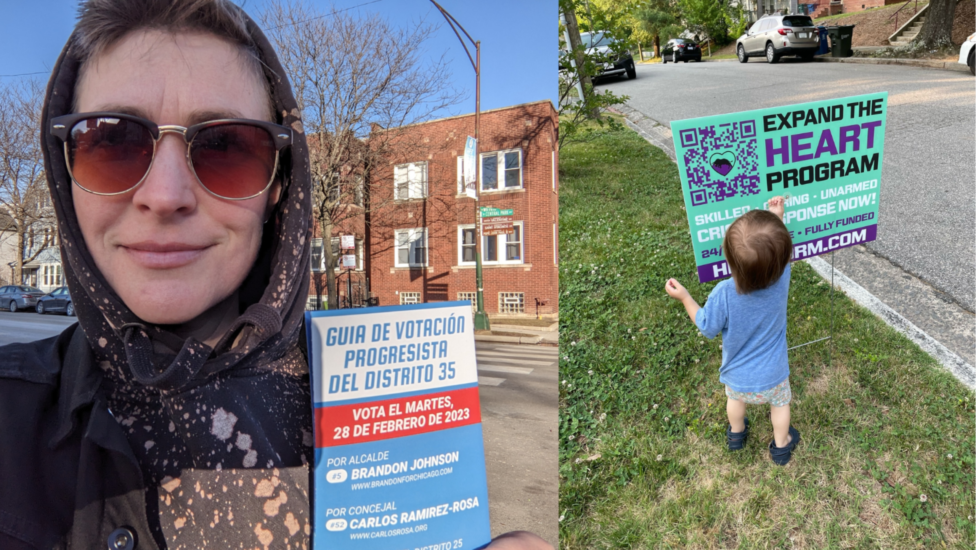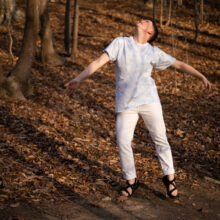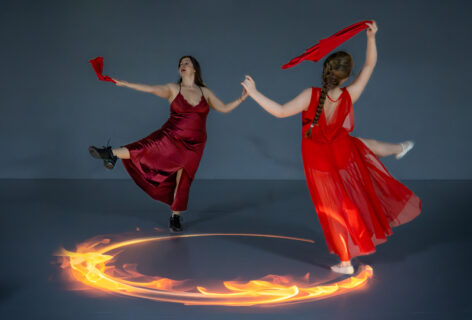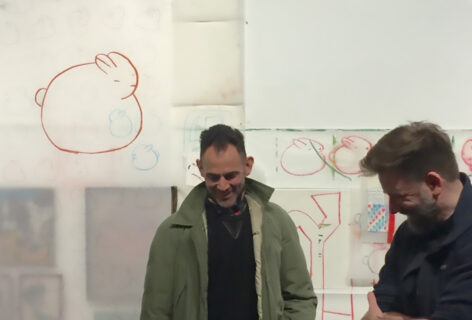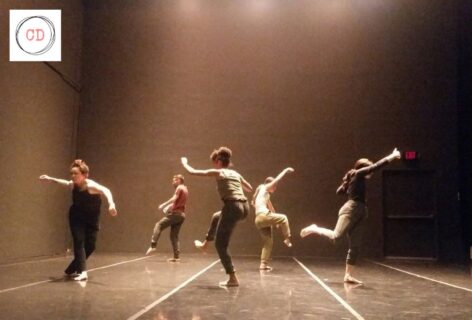Nora Sharp and Londs Reuter in Conversation
Londs Reuter: I am curious to start with your newsletter. I see you talking about action really broadly. And the voice of your newsletter positions your equivocations and convictions in a tone I find—even when angry—inclusive. How did you arrive at that tone?
Nora Sharp: I don’t know if I was aware or intentionally choosing that. I mean, I know what I’m doing. But, yeah, there’s just something about having you reflect that back to me that’s—wow, cool. When I built this, I didn’t know how it would land for people. But since you posed that question, I feel like I can look back and see it. Let me give some more context…
I was working on a grant application, probably a little over a year ago, and they always ask you: How will you build an audience? And I just said in the grant application that I was going to start a newsletter and that I would get 10 new subscribers every month. And then I did not get that particular grant, but I thought: I should still start a newsletter.
LR: Nice.
NS: I started thinking it would be promotional. Episode Two of The Real Dance was coming out. But I did not end up using it in that moment. I don’t think I used it for several months. And then, way later, I had this swell of ideas and clarity about applications and “specialness” culture, so I decided I needed to start. Hop on the surfboard and ride it towards the shore until you fall off.
I could feel, like—you gotta just send it out! Or else you’re going to get too scared! You might be too afraid that you might be wrong or have missed something! So just do it and accept that you might be wrong. That was in August of last year.
LR: I often find that the containers I set up for one purpose often serve a totally different need. Sometimes the container precedes the idea emerging…
NS: Yes. It opened up this space for me to feel a sense of permission and greater confidence and enthusiasm about saying whatever it is I have to say and feel a coherence around.
There’s also something about it being a newsletter and not something else. I didn’t ask for space in a publication. You all signed up! Or you came to look at this. It’s an “opt-in” space where I’m just over here doing this thing and if you want to hang out with me or respond, that’s great. But it feels like, in contrast to if I was seeking publication somewhere, I didn’t go out of my way to ask for that attention. This lets me play around and try things out. It’s not as high stakes as it might otherwise be. It’s really been like a discovery. I thought it was going to be one thing and then, suddenly, it became a channel for something else.
LR: It’s a channel! Of course.

[ID: Nora, with cropped blonde hair, crouches on the ground over a keyboard, looping pedals, and a microphone. They are wearing a light blue fleece. Red cuffed trousers, blue striped socks, and black Adidas soccer shoes.]
Photo by Ricardo E. Adame
NS: I’ve created a space where I can figure things out and be in conversation with others without demanding an audience. That’s what I love about this consensual “opt-in” situation. People can remove themselves whenever they want to. So if I want to, say, put up a poem I wrote about winter biking six years ago, I can do that and not worry that it won’t be received.
LR: Yeah, I see this flexibility of topics. It’s all related and the way you follow your curiosity lets the reader find the overlaps and intersections. Intersections between practical biking tips to feeling sick with desire and gender dysphoria to voting for candidates you care about…
NS: All this means that I’m writing about things I’ve been fucking chewing on for years. I mean, there’s one piece that I wrote that was about gender shit and Adult Dance learning culture. Since then, even in this conversation, I’m getting ideas all the time. This font of possibility has really opened up.
LR: Such acceleration!
NS: At the same time, I do try to be choosy. I don’t just send whatever. I do still feel that sense of responsibility that I want to be pretty confident that this is going to be worth someone’s while.
Of course, it can be used for these more practical purposes, like putting out a call for collaborators like I did recently. Or other purposes, like sending out political scripts and inviting people to go knock doors for Brandon Johnson, or whatever.
But yeah, this newsletter can be whatever I need it to be. And that’s been pretty cool.
LR: The way this “opt-in” ideology translates for me, as a reader, is a tone that feels really reflexive. Really conversational. Which is why I asked you to have a conversation with me! We’ve never met in person, but I read your writing and feel like I could hit reply and say: What do you mean by this?
I see this in the footer of the newsletter and appreciate it so much. It’s freeing! Copying and pasting:
“Thanks for reading Nor Art. I don’t track open rates or unsubscribes, so please always do what you need to do 🙂 I can also be bashful about replying to replies, but please know that they mean so much.”
At some point in your writing you said something like: I might disagree with this later… and then proceeded to make a point. That was a little explosion for me reading it, because you can change your mind! You can unsubscribe! The internet can calcify things forever, but we’re still only human. And yeah, you can disagree with yourself later. Keep evolving and do that in public.
NS: That’s really nice to hear the tone lands that way. Thank you.
To give credit where credit’s due, my partner, Grace McCants—who’s also my creative collaborator on some projects—she will literally say: Hmm, I might disagree with this after I say it, but I’m just gonna try it out for a second. And then will go forth! Seeing that level of permission has been a tool and a teacher for me. It’s become a major part of how I talk and process.
LR: You mentioned “specialness” culture earlier and I really love the way you talk about what gets rewarded within our field. Would you talk a little bit more about that?

[ID: An open computer sits on a wooden desk by a stack of books and a worn down notebook. The screen is open to a drafted blog post entitled: Who Thinks They Can Offer What in Exchange for Creative Labor?”]
Photo by Nora Sharp
NS: This is a good segue from the “I might disagree” topic because this is an area I’m always dicey or shifting on. I guess what I’ll say for now—and I said something to this effect in the piece I wrote about it—is that even while I myself constantly pursue things that I’d put into the “specialness” category, of basically highly competitive opportunities made available by established organizations or funders that tend to signify or designate some level of relevance or competence or quality in creative communities—not only is it a bummer to feel the emotional highs and lows that winning and losing in that economy creates in myself, but it makes me sad to imagine my peers and fellow communities and artists in general having to shape their practice around competing for these. There have been eras in my artistic life when I felt more surrounded by community-based spaces and performance opportunities that artists were creating by themselves and for each other, and I will say I feel that plethora or ecosystem regrowing a bit in the moment where we are since the pandemic began. That base layer of community shared space outside the specialness economy is so crucial to artists being able to grow and even discover what their practice is, and it’s my intention to invest my time and energy in those spaces as much as I can. I’m feeling hopeful on that front.
LR: A question that I’ve been holding these days is: What satisfies my need for dancing? Can writing a newsletter do that? I get that lots of things can be choreographic, but it doesn’t always involve my body dancing. This distinction feels important to me, as a person who has an appetite for choreography and for dancing. I wonder how moving across these different mediums may or may not satisfy desires around dancing.
NS: Yeah. This isn’t a direct answer to that. But I remember Miguel Gutierrez saying in LANDING a few years ago something like: Dancing can be dancing and it doesn’t have to be other things.
I remember him saying this with regards to really explicitly political dance content – and of course, memory could be wrong here, so I want to give credit while also acknowledging Miguel may not concur with my memory or interpretation. But the idea I took away was: You can also register people to vote. You can also go to a protest. I just remember realizing that things you care about can show up across mediums—and sometimes that works really well! For example, the way that I might work to get clarity about a dance project might be similar to the ways that I work to get clarity on a written project. But I also think there are things that are specific to a form. And that’s perfectly all right and in some ways, quite sensical.
This isn’t in contrast to the reality that many artists’ work is inherently political or politicized. But to the extent that some folks might feel an internal or, particularly for artists of marginalized identities, external pressure to make their work be capital-A About something that might get labeled political, and given that that can lead to heavy-handed content or, alternately, just not making the work you actually want to make—I found it helpful to be like, there are a lot of different tools available to us, our values can live in many places, and it’s good for artists to feel the room to pivot across those parts of ourselves.
LR: Yeah, like dancing can train you to be good at door-knocking, but maybe door-knocking doesn’t have to be dancing. Always. Ever? Yeah.
NS: Or it’s okay if those things, at the very least, don’t have to be conflated or something. Right. They can be distinct.
LR: So dancing can be dancing and dancing can also be writing a newsletter. Sometimes.
NS: Sometimes. Exactly.
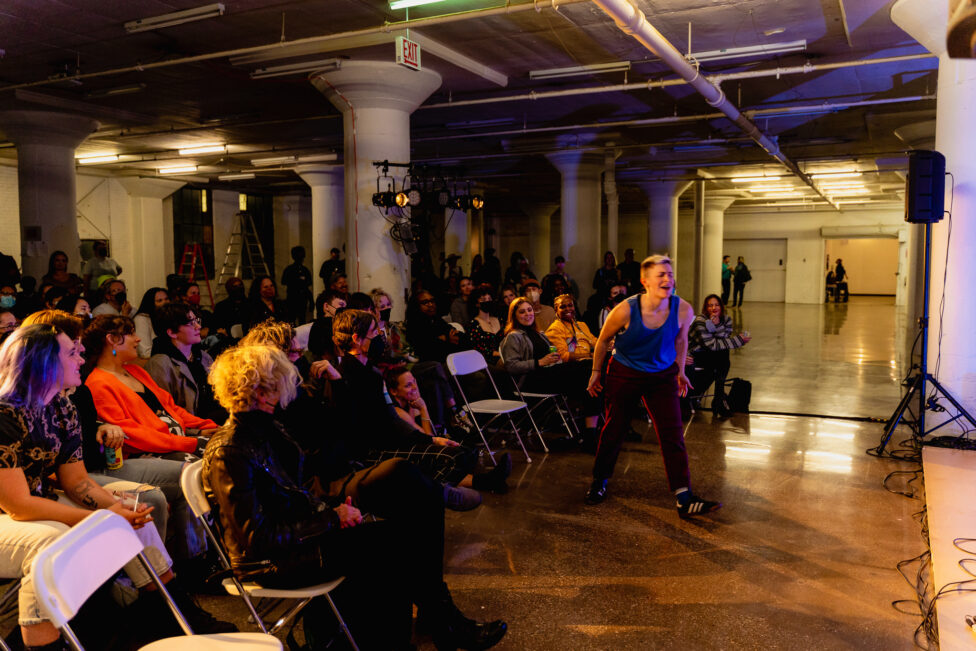
[ID: Nora walks away from the audience with an angsty expression and their palms facing outwards. Many audience members are smiling.]
Photo by Ricardo E. Adame

